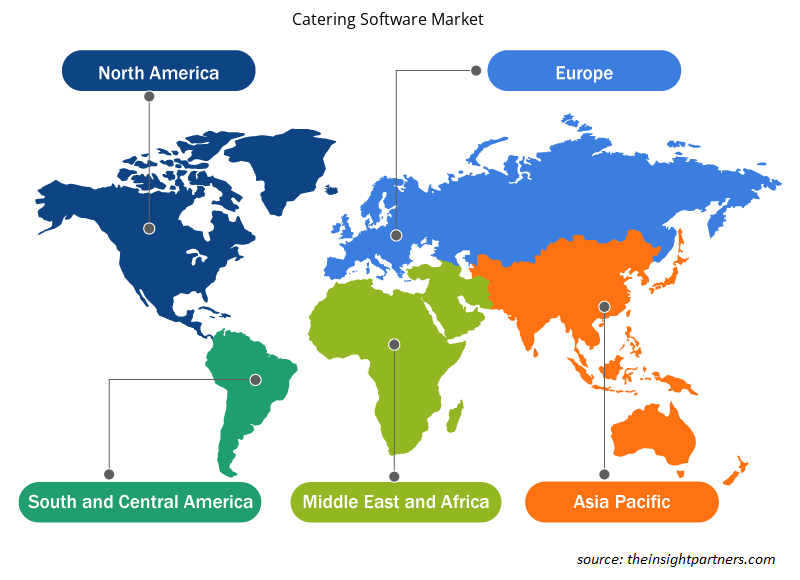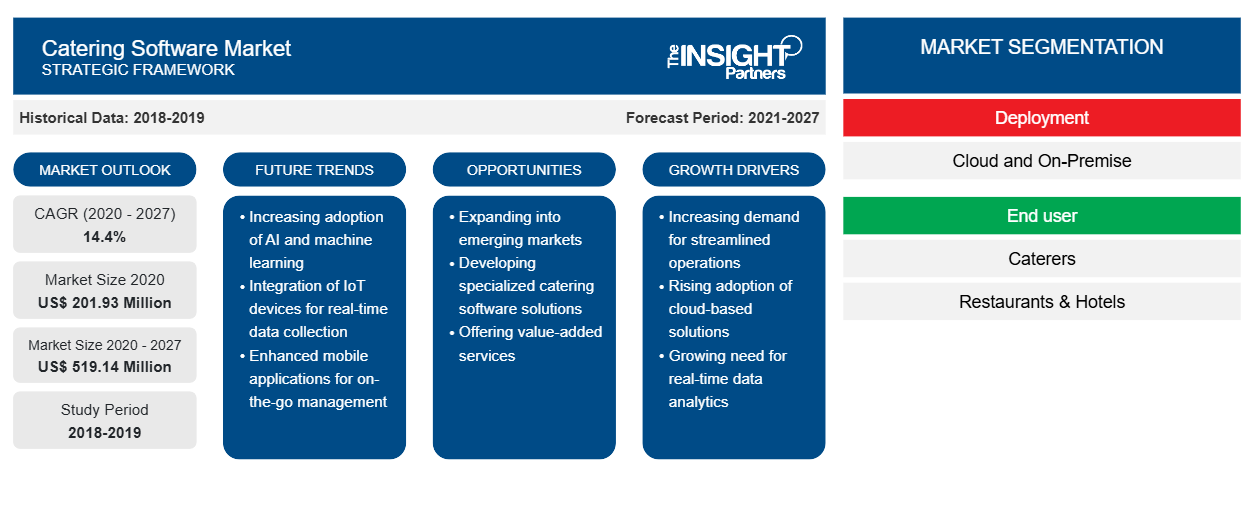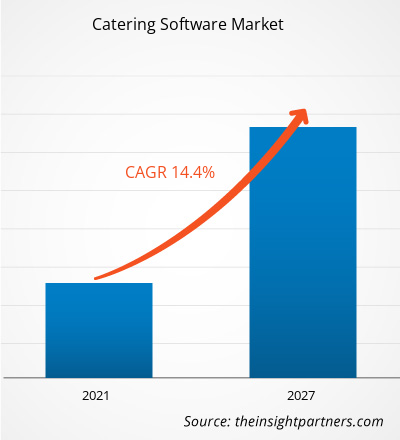Le marché des logiciels de restauration devrait passer de 201,93 millions de dollars américains en 2020 à 519,14 millions de dollars américains en 2027 ; il devrait croître à un TCAC de 14,4 % de 2020 à 2027.
La technologie d'analyse du Big Data pour améliorer les opérations de restauration contribue à la croissance du marché. La technologie d'analyse du Big Data a un énorme potentiel pour transformer complètement le secteur de la restauration. L'adoption de solutions Big Data contribue à améliorer l'efficacité des réseaux de distribution et de production dans l'ensemble du secteur de la restauration. La technologie permet de suivre l'ensemble du processus de transport des fournitures. Grâce à des informations en temps réel, les clients peuvent suivre leurs commandes d'achat sur leurs appareils et vérifier l'état de la restauration. L'intégration d'un tableau de bord d'analyse dans un logiciel de restauration permet de suivre et d'évaluer les performances des agents de restauration. En outre, chaque partie prenante du secteur de la restauration doit disposer de données pertinentes sur ses produits, notamment des données relatives aux agriculteurs, aux expéditeurs et aux détaillants, en terminant par les restaurants et les magasins. Par exemple, le restaurant KFC utilise des outils Big Data pour analyser les commentaires des clients et les préférences alimentaires, ce qui conduit à de meilleures expériences client, ventes et bénéfices.
Le secteur du commerce électronique dans toutes les régions a connu de nombreuses transformations au cours des dernières années. La croissance du secteur a incité les acteurs du marché des logiciels de restauration à tirer parti de l'analyse du Big Data pour prendre des décisions commerciales plus judicieuses. Cette technologie permet aux détaillants en ligne d'évaluer les interactions des clients sur les différents canaux, tels que les appareils mobiles, les réseaux sociaux et les sites Web.
Personnalisez ce rapport en fonction de vos besoins
Vous bénéficierez d'une personnalisation gratuite de n'importe quel rapport, y compris de certaines parties de ce rapport, d'une analyse au niveau des pays, d'un pack de données Excel, ainsi que de superbes offres et réductions pour les start-ups et les universités.
- Obtenez les principales tendances clés du marché de ce rapport.Cet échantillon GRATUIT comprendra une analyse de données, allant des tendances du marché aux estimations et prévisions.
Impact de la pandémie de COVID-19 sur le marché des logiciels de restauration
Suite à l'épidémie mondiale de COVID-19, certaines entreprises ont été contraintes de réduire leurs activités en raison de diverses mesures de confinement émises par les gouvernements du monde entier. La propagation rapide du virus a incité les gouvernements du monde entier à imposer des restrictions strictes à la circulation des personnes et des véhicules. Les entreprises qui dépendent des interactions physiques pour générer des revenus ont été gravement touchées par les confinements. En conséquence, certaines entreprises se concentrent sur l'augmentation des conversions, des interactions et des revenus via les médias numériques.
Informations sur le marché – Marché des logiciels de restauration
Le Machine Learning va révolutionner le secteur de la restauration
Dans le secteur de la restauration, l'insuffisance de la cartographie des zones et le déséquilibre entre la demande et la disponibilité des ressources entraînent plusieurs défis. L'apprentissage automatique et l'intelligence artificielle (IA) sont les fondements des technologies de restauration de nouvelle génération. Ces technologies permettent aux systèmes d'apprendre à partir de données enregistrées, qui comprennent des algorithmes, des modèles et des informations prédictives. Plusieurs entreprises de livraison de nourriture en ligne adoptent la technologie de l'apprentissage automatique pour améliorer leur activité de restauration et accroître l'efficacité de leurs activités. Par exemple, Deliveroo, une entreprise de livraison de nourriture basée au Royaume-Uni, investit dans des technologies avancées telles que l'apprentissage automatique pour rester compétitive sur le marché en offrant un service de livraison de nourriture plus efficace. Glovo, une entreprise de livraison de nourriture basée en Espagne, utilise également l'apprentissage automatique pour prévoir la probabilité de rester actif sur l'application. Ainsi, l'intégration de l'apprentissage automatique dans les entreprises de restauration devrait stimuler la demande de logiciels de restauration au cours de la période de prévision.
Informations basées sur le déploiement
En fonction du type de déploiement, le marché des logiciels de restauration est segmenté en cloud et sur site. Le segment cloud détenait la plus grande part de marché en 2019.
Aperçu régional du marché des logiciels de restauration
Les tendances et facteurs régionaux influençant le marché des logiciels de restauration tout au long de la période de prévision ont été expliqués en détail par les analystes d’Insight Partners. Cette section traite également des segments et de la géographie du marché des logiciels de restauration en Amérique du Nord, en Europe, en Asie-Pacifique, au Moyen-Orient et en Afrique, ainsi qu’en Amérique du Sud et en Amérique centrale.

- Obtenez les données régionales spécifiques au marché des logiciels de restauration
Portée du rapport sur le marché des logiciels de restauration
| Attribut de rapport | Détails |
|---|---|
| Taille du marché en 2020 | 201,93 millions de dollars américains |
| Taille du marché d'ici 2027 | 519,14 millions de dollars américains |
| Taux de croissance annuel composé mondial (2020-2027) | 14,4% |
| Données historiques | 2018-2019 |
| Période de prévision | 2021-2027 |
| Segments couverts | Par déploiement
|
| Régions et pays couverts | Amérique du Nord
|
| Leaders du marché et profils d'entreprises clés |
|
Densité des acteurs du marché des logiciels de restauration : comprendre son impact sur la dynamique des entreprises
Le marché des logiciels de restauration connaît une croissance rapide, tirée par la demande croissante des utilisateurs finaux en raison de facteurs tels que l'évolution des préférences des consommateurs, les avancées technologiques et une plus grande sensibilisation aux avantages du produit. À mesure que la demande augmente, les entreprises élargissent leurs offres, innovent pour répondre aux besoins des consommateurs et capitalisent sur les tendances émergentes, ce qui alimente davantage la croissance du marché.
La densité des acteurs du marché fait référence à la répartition des entreprises ou des sociétés opérant sur un marché ou un secteur particulier. Elle indique le nombre de concurrents (acteurs du marché) présents sur un marché donné par rapport à sa taille ou à sa valeur marchande totale.
Les principales entreprises opérant sur le marché des logiciels de restauration sont :
- Systèmes Aptus Ltée.
- Better Cater, Inc
- Logiciel Caterease
- CaterTrax, Inc.
- CaterZen de Restaurant & Catering Systems
Avis de non-responsabilité : les sociétés répertoriées ci-dessus ne sont pas classées dans un ordre particulier.

- Obtenez un aperçu des principaux acteurs du marché des logiciels de restauration
Les acteurs opérant sur le marché des logiciels de restauration se concentrent principalement sur le développement de produits avancés et efficaces.
- En 2020, CaterZen a investi des heures de programmation depuis début mars pour confirmer que les restaurants et les traiteurs peuvent poursuivre leurs opérations en se concentrant fortement sur les commandes en ligne et la livraison de nourriture.
- En 2020, Flex Catering a lancé le système de restauration KDS (Kitchen Display System), un type d'écran numérique qui remplace les commandes de tickets imprimés ou manuscrits dans les restaurants et les entreprises alimentaires.
Le marché des logiciels de restauration a été segmenté comme suit :
Logiciel de restauration globale - Par déploiement
- Nuage
- Sur site
Logiciel de restauration globale - Par utilisateur final
- Traiteurs
- Restaurants et hôtels
- Autres
Marché mondial des logiciels de restauration – par géographie
Amérique du Nord
- NOUS
- Canada
- Mexique
Europe
- France
- Allemagne
- Italie
- Russie
- ROYAUME-UNI
- Reste de l'Europe
Asie-Pacifique (APAC)
- Japon
- Chine
- Australie
- Inde
- Corée du Sud
- Reste de l'APAC
Moyen-Orient et Afrique (MEA)
- Arabie Saoudite
- Émirats arabes unis
- Afrique du Sud
- Reste de la MEA
Amérique du Sud (SAM)
- Brésil
- Argentine
- Reste de SAM
Marché des logiciels de restauration – Profils d’entreprises
- Systèmes Aptus Ltée.
- Better Cater, Inc
- Logiciel Caterease
- CaterTrax, Inc.
- CaterZen de Restaurant & Catering Systems
- Restauration flexible
- Logiciel de restauration FoodStorm (CaterXpress)
- Planification Pod (Mon classeur de mariage, LLC)
- Systèmes Profit Inc.
- Pxier
- Analyse historique (2 ans), année de base, prévision (7 ans) avec TCAC
- Analyse PEST et SWO
- Taille du marché Valeur / Volume - Mondial, Régional, Pays
- Industrie et paysage concurrentiel
- Ensemble de données Excel



Report Coverage
Revenue forecast, Company Analysis, Industry landscape, Growth factors, and Trends

Segment Covered
This text is related
to segments covered.

Regional Scope
North America, Europe, Asia Pacific, Middle East & Africa, South & Central America

Country Scope
This text is related
to country scope.
Questions fréquemment posées
The catering software market is led by cloud segment with highest share and is expected to dominate in the forecast period. The cloud segment generates the majority of the demand since it is comparatively less expensive and due to strong network infrastructure in developed countries. In addition, the cloud-based browser isolation software vendors are highly focused on developing a high-level security patch in order to eliminate the risk of cyber-attack.
The growth of the catering software market is primarily attributed to growing popularity of e-commerce platforms. Moreover, increasing integration of payment gateway, thereby substantially driving the catering software software market.
The Big Data analytics technology has enormous potential to completely transform the catering business. The adoption of Big Data solutions helps improve the efficiency of distribution and production networks in the overall catering industry. The technology allows tracking the entire process of the transportation of supplies. With real-time insights, customers can track their purchase orders on their devices and check the catering status. The integration of an analytics dashboard in catering software helps track and evaluate the performance of catering agents. Also, every stakeholder in the catering business must have relevant data on their products, including data related to farmers, shippers, and retailers, ending with restaurants and shops.
Trends and growth analysis reports related to Technology, Media and Telecommunications : READ MORE..
The List Companies - Catering Software Market
- Aptus Systems Ltd.
- Better Cater, Inc
- Caterease Software
- CaterTrax, Inc.
- CaterZen by Restaurant & Catering Systems
- Flex Catering
- FoodStorm Catering Software (CaterXpress)
- Planning Pod (My Wedding Workbook, LLC)
- Profit Systems Inc.
- Pxier
The Insight Partners performs research in 4 major stages: Data Collection & Secondary Research, Primary Research, Data Analysis and Data Triangulation & Final Review.
- Data Collection and Secondary Research:
As a market research and consulting firm operating from a decade, we have published and advised several client across the globe. First step for any study will start with an assessment of currently available data and insights from existing reports. Further, historical and current market information is collected from Investor Presentations, Annual Reports, SEC Filings, etc., and other information related to company’s performance and market positioning are gathered from Paid Databases (Factiva, Hoovers, and Reuters) and various other publications available in public domain.
Several associations trade associates, technical forums, institutes, societies and organization are accessed to gain technical as well as market related insights through their publications such as research papers, blogs and press releases related to the studies are referred to get cues about the market. Further, white papers, journals, magazines, and other news articles published in last 3 years are scrutinized and analyzed to understand the current market trends.
- Primary Research:
The primarily interview analysis comprise of data obtained from industry participants interview and answers to survey questions gathered by in-house primary team.
For primary research, interviews are conducted with industry experts/CEOs/Marketing Managers/VPs/Subject Matter Experts from both demand and supply side to get a 360-degree view of the market. The primary team conducts several interviews based on the complexity of the markets to understand the various market trends and dynamics which makes research more credible and precise.
A typical research interview fulfils the following functions:
- Provides first-hand information on the market size, market trends, growth trends, competitive landscape, and outlook
- Validates and strengthens in-house secondary research findings
- Develops the analysis team’s expertise and market understanding
Primary research involves email interactions and telephone interviews for each market, category, segment, and sub-segment across geographies. The participants who typically take part in such a process include, but are not limited to:
- Industry participants: VPs, business development managers, market intelligence managers and national sales managers
- Outside experts: Valuation experts, research analysts and key opinion leaders specializing in the electronics and semiconductor industry.
Below is the breakup of our primary respondents by company, designation, and region:

Once we receive the confirmation from primary research sources or primary respondents, we finalize the base year market estimation and forecast the data as per the macroeconomic and microeconomic factors assessed during data collection.
- Data Analysis:
Once data is validated through both secondary as well as primary respondents, we finalize the market estimations by hypothesis formulation and factor analysis at regional and country level.
- Macro-Economic Factor Analysis:
We analyse macroeconomic indicators such the gross domestic product (GDP), increase in the demand for goods and services across industries, technological advancement, regional economic growth, governmental policies, the influence of COVID-19, PEST analysis, and other aspects. This analysis aids in setting benchmarks for various nations/regions and approximating market splits. Additionally, the general trend of the aforementioned components aid in determining the market's development possibilities.
- Country Level Data:
Various factors that are especially aligned to the country are taken into account to determine the market size for a certain area and country, including the presence of vendors, such as headquarters and offices, the country's GDP, demand patterns, and industry growth. To comprehend the market dynamics for the nation, a number of growth variables, inhibitors, application areas, and current market trends are researched. The aforementioned elements aid in determining the country's overall market's growth potential.
- Company Profile:
The “Table of Contents” is formulated by listing and analyzing more than 25 - 30 companies operating in the market ecosystem across geographies. However, we profile only 10 companies as a standard practice in our syndicate reports. These 10 companies comprise leading, emerging, and regional players. Nonetheless, our analysis is not restricted to the 10 listed companies, we also analyze other companies present in the market to develop a holistic view and understand the prevailing trends. The “Company Profiles” section in the report covers key facts, business description, products & services, financial information, SWOT analysis, and key developments. The financial information presented is extracted from the annual reports and official documents of the publicly listed companies. Upon collecting the information for the sections of respective companies, we verify them via various primary sources and then compile the data in respective company profiles. The company level information helps us in deriving the base number as well as in forecasting the market size.
- Developing Base Number:
Aggregation of sales statistics (2020-2022) and macro-economic factor, and other secondary and primary research insights are utilized to arrive at base number and related market shares for 2022. The data gaps are identified in this step and relevant market data is analyzed, collected from paid primary interviews or databases. On finalizing the base year market size, forecasts are developed on the basis of macro-economic, industry and market growth factors and company level analysis.
- Data Triangulation and Final Review:
The market findings and base year market size calculations are validated from supply as well as demand side. Demand side validations are based on macro-economic factor analysis and benchmarks for respective regions and countries. In case of supply side validations, revenues of major companies are estimated (in case not available) based on industry benchmark, approximate number of employees, product portfolio, and primary interviews revenues are gathered. Further revenue from target product/service segment is assessed to avoid overshooting of market statistics. In case of heavy deviations between supply and demand side values, all thes steps are repeated to achieve synchronization.
We follow an iterative model, wherein we share our research findings with Subject Matter Experts (SME’s) and Key Opinion Leaders (KOLs) until consensus view of the market is not formulated – this model negates any drastic deviation in the opinions of experts. Only validated and universally acceptable research findings are quoted in our reports.
We have important check points that we use to validate our research findings – which we call – data triangulation, where we validate the information, we generate from secondary sources with primary interviews and then we re-validate with our internal data bases and Subject matter experts. This comprehensive model enables us to deliver high quality, reliable data in shortest possible time.


 Obtenez un échantillon gratuit pour ce rapport
Obtenez un échantillon gratuit pour ce rapport